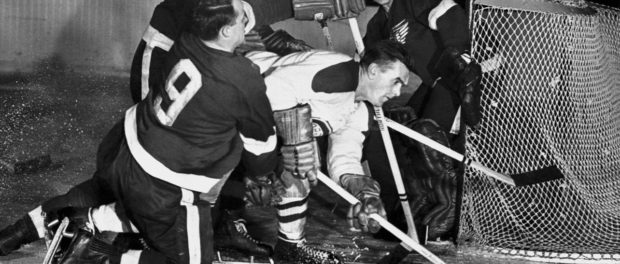1955: The Other Maurice & Other Quebec Curios
Part of “Shadows and Revolution”, 1900-1960
As Maurice Duplessis reigned the world politics, there was another Maurice who reigned the hearts and minds of sports fanatics: Maurice Richard, the star hockey player of the Montreal Canadiens and seen by many of the Francophone population as a French-Canadian hero.
The NHL, founded back in 1917, had six teams in the 1950s, including the Montreal Canadiens, the Boston Bruins, and the Toronto Maple Leafs. Its president of the time, Clarence Campbell, had somewhat of a dislike to Richard, and the feeling was mutual. Campbell, however, would show that he had the upper hand one evening in 1955.
In March, Maurice Richard and his teammates played against the Bruins in Boston when Hal Laycoe, a hockey player for the Bruins, attacked him with his hockey stick, cutting Richard on the head. In response, Richard, known for his fiery temperament on the ice, broke his own hockey stick on Laycoe’s back. Depending on which story you believe, a third player, Cliff Thompson of the Boston Bruins either skated over to help—or helped restrain Richard, allowing Laycoe to attack him. In the end, Richard punched Laycoe and was penalised in-game.
This incident didn’t end here: Campbell decided to suspend Richard for the rest of the season. One of the big problems with Campbell’s suspension was that there had been violent incidents during games in the past involving Anglophone players that did not involve suspension. Yet Richard, a French-Canadian, was the one who was suspended, whereas Laycoe did not receive any penalties post-game despite having been the one to start the altercation.
Tensions brewed during that week and finally broke into an all-out riot on St. Patrick’s Day. While the Canadiens played the Detroit Red Wings in the Forum, Campbell made the very daring decision to come to the game and sit in his regular place. To make matters worse, he decided to enter ten minutes late, so that he may be seen. The crowd booed his entrance and a crowd started forming outside the Forum. The crowd grew so much that the police intervened, causing the mood to grow hostile. People started to smash windows and become disorderly, and eventually, someone set off a tear gas bomb. The game inside the Forum was called off, with a Red Wings win, and the crowd inside and outside met. Businesses all around the Forum were broken into, vandalised, and looted, and twenty-five people were injured. The police arrested over one hundred people. The following day, Richard came on television and plead with the people, in a message done in both English and French, to stop the violence. Almost miraculously, Québec’s favourite hockey player’s demands were met.
Contemporary historians have ascribed the Richard Riots with a bigger purpose than a bunch of fans fighting the suspension of their favourite player. In a time where Anglophones such as Campbell were at the very top of the economic ladder, the suspension of the best French-Canadian hockey player sent a shock through Canadiens fans, but their disbelief at the suspension went further than the fact that it was unjust. French-Canadian historians and analysts saw it more as an ethnic and cultural struggle, English against French, and the fact that an Anglophone man who detested one of the highest-performing French-Canadian player was able to so easily extract his revenge was the most unjust thing about it. Some historians go as far as to saying that the Richard Riots was the beginning of the path towards modernisation of the province.
Maurice Richard retired five years after the riots, in 1960. His score of winning fifty points in fifty games remained undefeated until Mike Bossy’s score of fifty-three points in fifty games in the 1980s.






